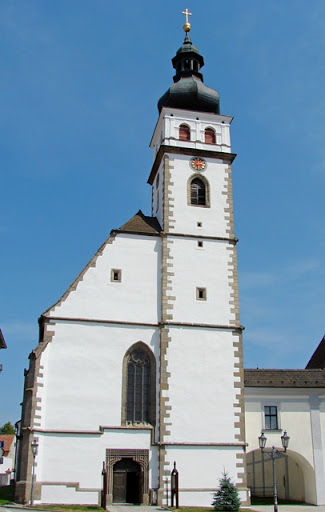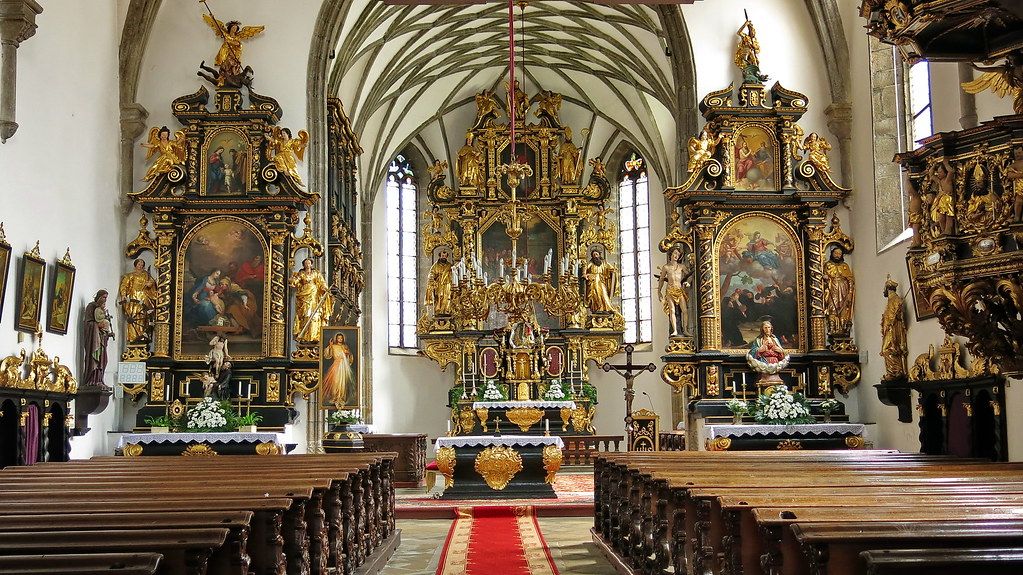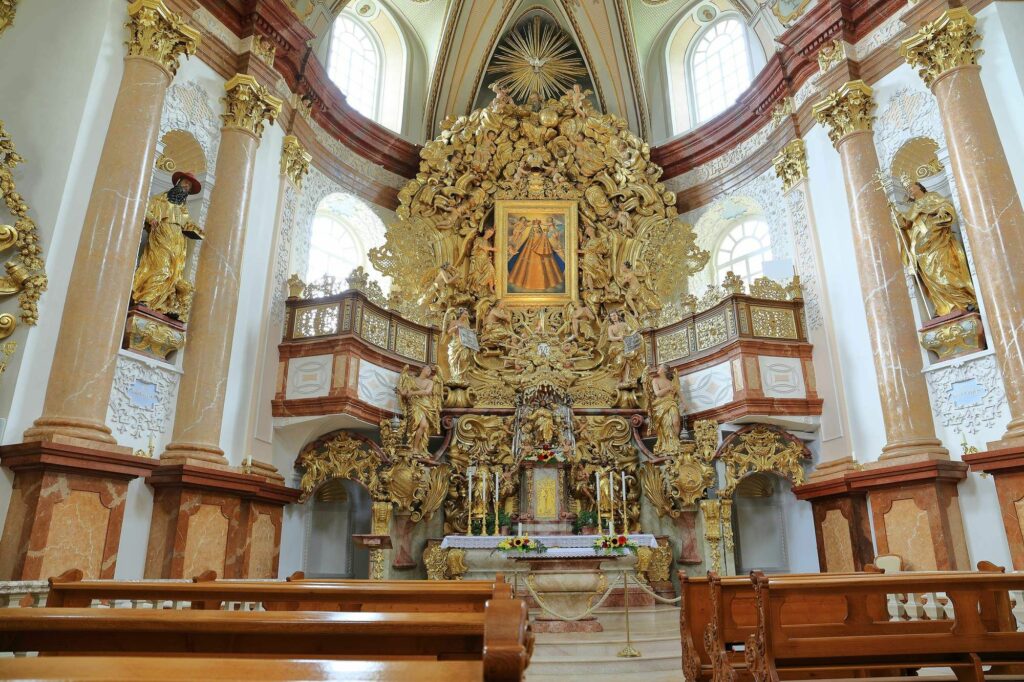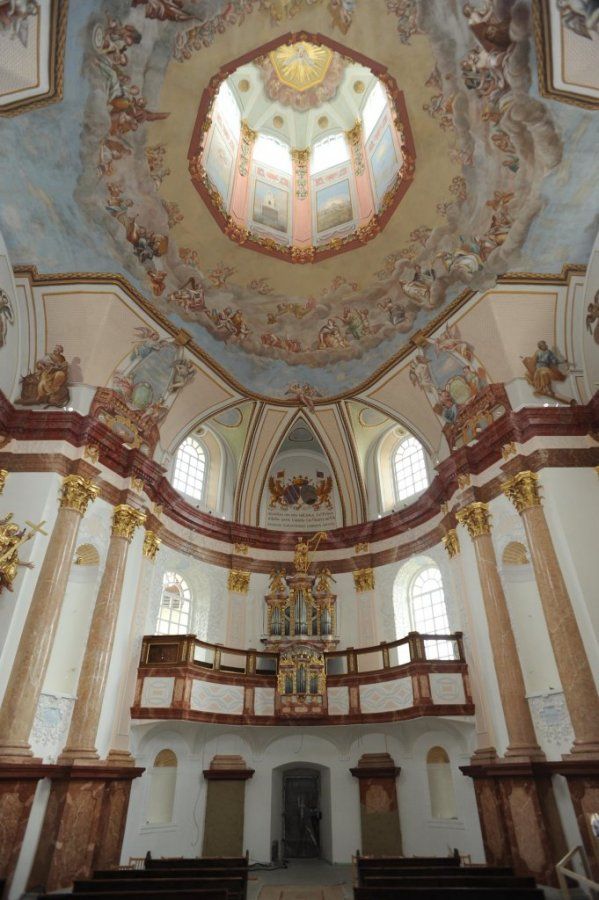The priests of the Virgin Mary Family currently administer parishes:
– Nové Hrady
– Dobrá Voda u N. Hradů
– Horní Stropnice
– Trhové Sviny
– Olešnice
The history of the Nové Hrady church

The first mention of the Parish Church of the Sts. Peter and Paul at Nové Hrady originates from 1284. The church which stands there now was built 300 years later. The town of Nové Hrady was destroyed in 1425 by Taborites (a religious community centred on the Bohemian city of Tábor during the Hussite Wars in the 15th century). In 1467, before the town could recover, it was burnt down to ashes by Zdeněk von Šternberk, who took revenge on Jan of Rosenberg for being loyal to King George of Poděbrady. We can guess from the building history of the current church what kind of difficulties the town faced at that time. The building of the Church begun around 1500 and the late gothic nave was finished by 1590. So it is the last complex gothic work in Bohemia and it deserves our recognition. Only the tower, which was hit by lightning in 1607, was rebuilt in Renaissance style. In 1726 the tower received the eight-sided bulbous dome, which has remained there until now. Spiritual management was provided by the order of the Cistercians from Vyšší Brod and it was the same in the surroundings: at Stropnice, Rychnov and later also at Dobrá Voda. In 1677 the Monastery of the Servites was established. When the monastery was built, some alterations were made inside the Church too. The new sacristy and the oratory above were raised, and the Church was newly furnished in early baroque style. The main altar and both side altars by the arch of triumph are from 1678. The author is not known but the same altar can be found in the Church of St. Bartholomew in Pelhřimov. The pulpit, the confession booth and pews are from 1697, the floor was paved with granite flagstones in 1733. The picture on the main altar shows The Sending of Holy Spirit. Above it, there is the picture of Charles Borromeo of Milan, who died in 1584 and was canonized in 1610. At the end of the altar there is a statue of St. Wenceslaw, St. Sigmund and St. Adalbert of Prague. On the sides of the altar there are over life-size statues of St. Peter and St. Paul, the patrons of the Church. The reliefs on the pedestal of the altar demonstrate some events of their lives: an angel is releasing Peter from prison and Paul is being rescued by being let down in a basket from the curtain walls of Damascus to escape from death. Over the tabernacle there is a yellowed woodcut of the Virgin Mary of Good Advice (17 x 37 cm) in a valuable frame. Charles Bonaventura Buquoy found this picture in a burnt house at Záblatí in 1619. The altar of St. Anne is decorated with statues of St. Catherine and St. Barbara with a sword and a chalice. The altar is topped of with a statue of the Archangel Michael. On the altar of The Seven Holy Founders of the Servites there are statues of St. Sebastian, St. Rochus and at the top the statue of St. George. There are also other saints of the Order of the Servites: St. Peregrine under the cross on the altar of St. Anne and St. Phillip Benicius on the pulpit among four western church fathers.

The picture of Mary of Zablatí
The picture of „Virgin Mary Trost“ or „Virgin Mary of Záblatí“ with the size of 17 x 34 cm is situated on the main altar of the Church of Sts. Peter and Paul at Nové Hrady. It shows the figure of Virgin Mary with Jesus on her left arm on a half-moon iconographically. It is the woodcut that the Count Charles Bonaventura Buquoy saved from a burning house in The Battle of Záblatí near Vodňany. After that, he used to carry the picture with him and pray to Virgin Mary. When he had been killed in the campaign near Nové Zámky in Hungary, the Jesuit St. Ann’s Church in Vienna received the picture and there it used to enjoy great public adoration.
In 1674 the family of Buquoy requested that the picture be returned to Nové Hrady. The Countess Margaret Buquoy let the woodcut, which was black from the fire, be put into a frame with a gilded aureole. Every year thereafter there was a celebration on the feast of the Birth of the Blessed Virgin Mary in Nové Hrady. On June 11, 1753 the picture was hung on the main altar of the Servites´ Church and the Church became a place where many pilgrims from the surrounding areas came to visit. On May 8, 1974 people in the village of Volders in Tirol commemorating the picture having been transported to Nové Hrady. Up to the present Madonna of Záblatí is often portrayed on procession standards.
The history of Dobrá Voda church
The Rosenbergs´ archivist and genealogist, Václav Březan, wrote the biography of one of the last Rosenbergs, Vilém. In his biography he mentioned that in the domain of Nové Hrady above the village of Stropnice, continuing on to the Austrian border, a spring had been found containing water through which many people had been healed. There a village was founded and named after the Rosenberg – Vilémova Hora (Vilém´s Mount). Today the village is known as Hojná Voda (Healing Water). 130 years later, at the end of the 17th century, a new spring was found near Hojná Voda under the Kraví hora and the, spring as well as the newly established village, were named Dobrá Voda (Good Water). In the meantime the Rosenberg family died out. In 1611 the Rosenbergs´ domain was take over by the house of the Švamberks in the south eastern part of Bohemia. During this time a new suzerain appeared, the old French nobility, the house of Buquoy. Charles Bonaventura Buquoy received the domains of Nové Hrady, Rosenberg and Libějovice for his faithful service from the emperor Ferdinand II. His descendants built the pilgrimage Church of the Assumption of Virgin Mary near the newly found spring. The building of the church was preceded by two apparitions. The first of these apparitions was seen by the brothers Hans und Matěj from the small village Šlagles near Stropnice. On the feast of the Epiphany, 1698 they saw a crowd of people pilgriming to the column of the crucification which stood in the place of the new spring. When they told the others they all laughed at the two brothers. Matyáš Egidi, the son of a farmer from the village Bedřichov near Stropnice, received the second apparition one night in a dream in the year 1701. In his dream he was ordered to build a chapel on the place where he would find limestone. He found the limestone on there he built a chapel. Suddenly there were crowds of pilgrims coming to the place including people from as far away as Freistadt in Upper Austria or Třeboň in South Bohemia. Soon, the chapel was not large enough to accommodate all the pilgrims and so the Count Albert Charles Buquoy began with the building of a large church. He used charitable gifts and money from the pilgrims for this purpose and it made 634 gold coins in 1704.

The cornerstone was festively laid by the prelate Jan Jakub Bukovský from Český Krumlov on May 13 in 1706. The building of the church itself began two years later, in 1708. Neither the architect nor the planner are known. On August 1 in 1709 the first holy mass was celebrated there. The church was completely finished and dedicated by the prelate Sigismund Heuner from Český Krumlov on May 26, 1715. The rectory was finished in 1719 and the following year the rector Ringler settled down there. Until the 1950s the Cistercian Fr. Daniel Waschenpelz was as the last administrator there.
After the dedication the work continued in the interior of the new church. The main altar was gilded in 1718, the new organ was acquired in 1727, and the frescoes were painted in 1729. At the same time the village around the spring was growing rapidly. In 1717 there is mention of the small town of Dobrá Voda, which was given the right to hold markets and a town sign by the Count Charles Kajetán Buquoy. In the town sign there is a wooded hill on the blue background from which a spring gushes forth There is a small silver shield above the spring and in the shield there is a small golden bell. In 1718 the Count let a residence on the west side of the church be built. It functioned as a summerhouse. In 1818 the Buquoys allowed the whole village to use it and in 1852 they gave the building to the village as a gift (it was demolished in 1963). In 1786 there a graveyard was built near the church, prior to that, the deceased had been buried in Hojná Voda. In 1888 the Countess Filipina Buquoy allowed expensive restorations of the pilgrimage church to be done. Martin Josef Říha, the Bishop from České Budějovice, consecrated the newly restored church on October 14, 1888. The Pontifical Mass was celebrated by Leopold Wackarž, the Abbot from Vyšší Brod. At that time Dobrá Voda had 101 houses with 470 inhabitants, a church, a rectory, a public bath and a post office.

Much time has passed, many things have changed but it has not always been changes for the better. The old appearance of Dobrá Voda has been completely lost. Dobrá Voda depopulated after WW2. The worst incident that happened there was a fire that was caused by human carelessness. It happened on April 8, 1949. In the inn Panský, next to the eastern side of the church, there broke out a fire which completely destroyed twelve houses. Fortunately, the wind blew from the West, so the church remained miraculously untouched. During the Communist regime the pilgrimage place fell into total disrepair. The Buquoys´ residence was torn down in 1963, the inn called Panský, where the pilgrims used to stay overnight, was burnt and then torn down. Thanks to the sisters from the Congregatio Jesu the Baroque rectory didn’t suffer they same fate. They also managed to save the pilgrimage church. In 1987–1992 there was a thorough restoration of the outer shell of the pilgrimage church. Now, the wistful beauty of the magnificent pilgrimage sanctuary, under the patronage of Virgin Mary, to whom it is dedicated, is still visible from the basin of Třeboň and other corners of South Bohemia.
The pilgrimage church of the Assumption of the Virgin Mary is a registered cultural monument. Up to the displacement of German inhabitants in 1945, this pilgrimage place belonged to the most important Marian pilgrimage places in our country and it united pilgrims from Bohemia, Moravia, Austria, Germany and even from Slovakia, Hungary and Slovenia. Regarding the number of pilgrims, in 1913 Dobra Voda shared the10th place together with pilgrimage place in Stará Boleslav. It was even considered to be the most important place in the German-speaking parts of Southern and Western Bohemia. The importance and popularity of this place can be seen in it’s nickname„The Lourdes of South Bohemia“, which the well-known writer Zikmund Winter used to describe it.
The history of Horní Stropnice church
The village of Horní Stropnice is located on the old way from Weitra to Doudleby. The Czech Prince Friedrich enfeoffed the Weitra region including Horní Stropnice to Hadmar von Chuenring in 1185. It is likely that the first church at Horní Stropnice was built during his reign around 1200. In 1257 Vok of Rosenberg received the half of the village as the dowry of his wife Hedvika. The second part of the village belonged to Albert of Boršov, who called himself „of Stropnice“ from 1279. As far back as 1302 Horní Stropnice was promoted to a township or a small town and that meant that it was allowed to hold markets. Originally, there was a cow market every week and there was an annual market on the feast of the Ascension which Emperor Rudolf II confirmed in 1607. This privilege was confirmed by the Emperor Ferdinand I in 1848 and there were two other markets added, on February 5 and on November 6. The owners of the two halves of Horní Stropnice continually changed until 1359, then the whole Horní Stropnice was taken over by the Rosenbergs and they kept it until the extinction of their house in 1611. It had been shortly owned by Švamberk family before Charles Bonaventura Buquoy received it together with the domain of Nové Hrady in 1620. Mary Magdalene, the widow of Charles Bonaventura Buquoy, who died on July 10,1621 near Nové Zámky, exempted Horní Stropnice from all dues in 1623 because the village was very poor. In years 1476-1486 Horní Stropnice was pawned to Oldřich of Grafeneck. His enemy Rubík of Hlavatec burnt down the village including the church in 1486. That fire was a landmark in the building development of the Church. Originally, the Church was built in the Romanesque style and there was only one aisle. Elements of that style can be still observed on the tower. After being burned down the Church was arched over and it became three-aisled as are most of the Gothic churches are. The presbytery, the old sacristy and the clock tower above the western entrance were also built in the Gothic style (later adapted). This complex was later completed with a hall before the south entrance in the Renaissance style, with a new sacristy and an open chapel between the south entrance and the pillar in the Baroque style. Henry of Rosenberg entrusted the spiritual management to Cistercians of Vyšší Brod, who cared for it until 1945. The present region of parishes Hojná Voda and Dobrá Voda belonged also to this parish and they were disjoined during the reign of Joseph II. The graveyard was built next to the church until 1801. The Marian column on the square was built in 1765. The main altar is the work of monks of Vyšší Brod from 1649. In the picture St. Nicolaus is bowing down before the Virgin Mary with Child. In the background there are two angels holding a bishop’s crook and a bowl with apples. On the walls there are statues of two saints of the Order of Cistercians. At the top of the altar there is the picture of the Most Holy Trinity with statues of St. Veit and St. Wenceslaw. The altar is topped off with the archangel Michael. The original side altars were also from 1649 but they were replaced by new ones. After the Thirty Years War there remained only the font from the Gothic inventory. The Rococo pulpit was made by the carver Bernard Mayer from Hojná Voda in 1777. During 1990s the church was completely restored and it became a beautiful dominant feature of the square of Horní Stropnice again.